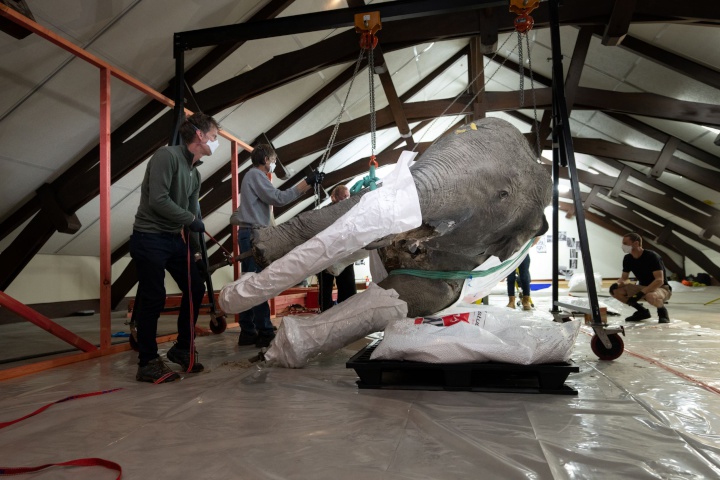Museum Whoppers Leave The Building
Ed Hillary’s tractor and a giant globe are among the last of the oversized objects to be craned out of Canterbury Museum this morning.

The elephant stuck in the Museum’s attic is gently lowered onto its side as it is prepared for removal.
Since September, the Museum has been shifting all the taonga (treasures) housed in its Rolleston Avenue buildings to secure off-site storage in preparation for the redevelopment.
Last week, a successful operation was carried out on the Museum’s elephant by an expert taxidermist who segmented it into pallet-sized pieces so that it could be moved out through the storeroom doors.
A hole had to be cut in the side wall of the Level 5 Whale Space storeroom last week to remove the skull and two jawbones of the Museum’s Ōkārito Blue Whale. The 1.5-tonne skull and jawbones, which together weigh almost a tonne, were moved through the wall onto a small roof area and craned down to a waiting truck in the Botanic Gardens. The whale skeleton – one of the largest in the world – will return to display in the atrium of the new Museum.
Now it’s the turn of some of the biggest remaining objects in the Museum’s care. A large window in the Museum’s Level 3 Visitor Lounge has been removed so that a crane, erected in the Botanic Gardens, can lift out these items.
The giant rotating globe which has hung in the Museum since 1975 is among the objects which will be wheeled out onto a scaffolding platform so that they can be craned out, as will the Tucker Sno-Cat Able that, as part of the Commonwealth Trans-Antarctic Expedition (1955–1958), was among the first vehicles to cross the Antarctic continent.
Sir Edmund Hillary’s modified Ferguson tractor, part of the same expedition, will also be removed, along with Ivan Mauger’s gold bike, a taxidermied rhinoceros and a number of slightly smaller objects from the Antarctic Gallery.
In leaving through the Visitor Lounge window, the Antarctic objects will exit the building the same way as they entered before the gallery opened in 1977.
Museum Director Anthony Wright says it’s exciting to see these large objects on the move after decades in one place. They follow the millions of smaller taonga that have been moved out into storage over the last 6 months.
“We’ve been looking forward to this moment with excitement and a little trepidation since we embarked on our redevelopment journey. It’s a major milestone. Our team have planned meticulously so these treasures can be safely moved.”
The taxidermied Indian elephant in the Museum’s Mammal Attic has been particularly challenging to extract. Earthquake strengthening in the 1990s trapped it inside, too large to get out through the only doors to the space.
The elephant was laid on its side using a gantry with a block and tackle. A lightweight cast was then made of the animal’s side which will help guide the reassembly process.
Due to the presence of harmful chemicals historically used in taxidermy, including arsenic, an isolation tent was erected around the elephant and the taxidermy team worked in full PPE to cut the elephant’s skin and remove the straw stuffing. The elephant will be restored for display in the new Museum. (Read how the elephant came to be at the Museum here).
“We’re actually not the first New Zealand museum to have to cut up a taxidermied elephant to get it out of the building. Auckland Museum’s elephant, Rajah, had to be modified to be moved out in the 1990s. These days it’s standard practice for taxidermists to cut large specimens into pieces before mounting them, so I’m in no doubt that the elephant will look better than it ever has when it’s back on display,” Anthony Wright says.
All the large objects will be taken by truck to the Museum’s secure warehouse complex, where they will be safe for the next 5 years while the Rolleston Avenue site redevelopment is underway.
These large objects are one of the final parts of the mammoth Museum move. The Museum buildings are on track to be empty by the end of April.


 Emirates Team NZ: Statement From Emirates Team NZ On Auckland Hosting Of 38th America’s Cup
Emirates Team NZ: Statement From Emirates Team NZ On Auckland Hosting Of 38th America’s Cup PPTA Te Wehengarua: Draft English Curriculum Lacks Connection With Reality
PPTA Te Wehengarua: Draft English Curriculum Lacks Connection With Reality Oratia Books: Revised Edition Of Much-praised History Examines The Great War Experience Of New Zealand, Australia And Canada
Oratia Books: Revised Edition Of Much-praised History Examines The Great War Experience Of New Zealand, Australia And Canada Brain Injury NZ: Creating Solutions - ID Card For People With Brain Injury Launched
Brain Injury NZ: Creating Solutions - ID Card For People With Brain Injury Launched University of Auckland: AI Leads To Breakthrough In Knee Surgery
University of Auckland: AI Leads To Breakthrough In Knee Surgery The Label: Independent Music NZ Announces Taite Music Prize IMNZ Classic Record 2025
The Label: Independent Music NZ Announces Taite Music Prize IMNZ Classic Record 2025